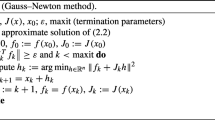Abstract
This paper describes a nonlinear least squares framework to solve a separable nonlinear ill-posed inverse problem that arises in blind deconvolution. It is shown that with proper constraints and well chosen regularization parameters, it is possible to obtain an objective function that is fairly well behaved and the nonlinear minimization problem can be effectively solved by a Gauss–Newton method. Although uncertainties in the data and inaccuracies of linear solvers make it unlikely to obtain a smooth and convex objective function, it is shown that implicit filtering optimization methods can be used to avoid becoming trapped in local minima. Computational considerations, such as computing the Jacobian, are discussed, and numerical experiments are used to illustrate the behavior of the algorithms. Although the focus of the paper is on blind deconvolution, the general mathematical model addressed in this paper, and the approaches discussed to solve it, arise in many other applications.
Similar content being viewed by others
References
Andrews, H., Hunt, B.: Digital Image Restoration. Prentice-Hall, Englewood Cliffs (1977)
Bardsley, J., Vogel, C.R.: A nonnegativly constrained convex programming method for image reconstruction. SIAM J. Sci. Comput. 25(4), 1326–1343 (2004)
Bardsley, J.M., Goldes, J.: Regularization parameter selection methods for ill-posed Poisson maximum likelihood estimation. Inverse Probl. 25(9) (2009). doi:10.1088/0266-5611/25/9/095,005
Bardsley, J.M., Merikoski, J., Vio, R.: The stabilizing properties of nonnegativity constraints in least-squares image reconstruction. IJPAM 43(1), 95–109 (2008)
Bardsley, J.M., Nagy, J.G.: Covariance-preconditioned iterative methods for nonnegatively constrained astronomical imaging. SIAM J. Matrix Anal. Appl. 27, 1184–1197 (2006)
Bertsekas, D.P.: Projected newton methods for optimization problems with simple constraints. SIAM J. Control Optim. 20, 221–246 (1982)
Bonettini, S., Zanella, R., Zanni, L.: A scaled gradient projection method for constrained image deblurring. Inverse Probl. 25, 015002 (2009). doi:10.1088/0266-5611/25/1/015002
Chung, J., Haber, E., Nagy, J.: Numerical methods for coupled super-resolution. Inverse Probl. 22(4), 1261–1272 (2006)
Chung, J., Nagy, J.: An efficient iterative approach for large-scale separable nonlinear inverse problems. SIAM J. Sci. Comput 31(6), 4654–4674 (2010)
Chung, J., Nagy, J.G., O’Leary, D.P.: A weighted GCV method for Lanczos hybrid regularization. Electron. Trans. Numer. Anal. 28, 149–167 (2008)
Chung, J., Sternberg, P., Yang, C.: High performance 3-D image reconstruction for molecular structure determination. Int. J. High Perform. Comput. Appl. 24(2), 117–135 (2010)
Frank, J.: Three-dimensional Electron Microscopy of Macromolecular Assemblies. Oxford University Press, New York (2006)
Golub, G.H., Pereyra, V.: The differentiation of pseudo-inverses and nonlinear least squares problems whose variables separate. SIAM J. Numer. Anal. 10(2), 413–432 (1973)
Golub, G.H., Pereyra, V.: Separable nonlinear least squares: the variable projection method and its applications. Inverse Probl. 19, R1–R26 (2003)
Haber, E., Ascher, U.M., Oldenburg, D.: On optimization techniques for solving nonlinear inverse problems. Inverse Probl. 16(5), 1263–1280 (2000)
Hansen, P.C., Nagy, J.G., O’Leary, D.P.: Deblurring Images: Matrices, Spectra and Filtering. SIAM, Philadelphia (2006)
Hohn, M., Tang, G., Goodyear, G., Baldwin, P.R., Huang, Z., Penczek, P.A., Yang, C., Glaeser, R.M., Adams, P.D., Ludtke, S.J.: SPARX, a new environment for Cryo-EM image processing. J. Struct. Biol. 157(1), 47–55 (2007)
Kang, M.G., Chaudhuri, S.: Super-resolution image reconstruction. IEEE Signal Proc. Mag. 20(3), 19–20 (2003)
Kaufman, L.: A variable projection method for solving separable nonlinear least squares problems. BIT 15(1), 49–57 (1975)
Kaufman, L., Pereyra, V.: A method for separable nonlinear least squares problems with separable equality constraints. SIAM J. Numer. Anal. 15, 12–20 (1978)
Kelley, C.T.: Iterative Methods for Optimization. SIAM, Philadelphia (1999)
Kelley, C.T.: Implicit Filtering. SIAM, Philadelphia (2011). Software and manual can be found at: http://www4.ncsu.edu/ctk/imfil.html
Lagendijk, R.L., Biemond, J.: Iterative Identification and Restoration of Images. Kluwer Academic Publishers, Boston (1991)
Landi, G., Piccolomini, E.L.: A projected newton-cg method for nonnegative astronomical image deblurring. Numer. Alg. 48, 279–300 (2008)
Landi, G., Piccolomini, E.L.: Quasi-newton projection methods and the discrepancy principle in image restoration. Appl. Math. Comput. 118, 2091–2107 (2011)
Marabini, R., Herman, G.T., Carazo, J.M.: 3D reconstruction in electron microscopy using ART with smooth spherically symmetric volume elements (blobs). Ultramicroscopy 72(1–2), 53–65 (1998)
Nocedal, J., Wright, S.: Numerical Optimization. Springer, New York (1999)
Osborne, M.R.: Separable least squares, variable projection, and the Gauss–Newton algorithm. Electron. Trans. Numer. Anal. 28, 1–15 (2007)
Penczek, P.A., Radermacher, M., Frank, J.: Three-dimensional reconstruction of single particles embedded in ice. Ultramicroscopy 40(1), 33–53 (1992)
Pruessner, A., O’Leary, D.P.: Blind deconvolution using a regularized structured total least norm algorithm. SIAM J. Matrix Anal. Appl. 24, 1018–1037 (2003)
Ruhe, A., Wedin, P.: Algorithms for separable nonlinear least squares problems. SIAM Rev. 22(3), 318–337 (1980)
Saban, S.D., Silvestry, M., Nemerow, G.R., Stewart, P.L.: Visualization of α-helices in a 6-Ångstrom resolution cryoelectron microscopy structure of adenovirus allows refinement of capsid protein assignments. J. Virol. 80(24), 49–59 (2006)
Sima, D.M., Huffel, S.V.: Separable nonlinear least squares fitting with linear bound constraints and its application in magnetic resonance spectroscopy data quantification. J. Comput. Appl. Math. 203, 264–278 (2007)
Snyder, D.L., Hammoud, A.M., White, R.L.: Image recovery from data acquired with a charge-coupled-device camera. J. Opt. Soc. Am. A 10, 1014–1023 (1993)
Snyder, D.L., Helstrom, C.W., Lanterman, A.D., Faisal, M., White, R.L.: Compensation for readout noise in ccd images. J. Opt. Soc. Am. A 12, 272–283 (1995)
Author information
Authors and Affiliations
Corresponding author
Additional information
The work of J. Nagy was supported by the NSF under grant DMS-0811031 and the AFOSR under grant FA9550-12-1-0084
Rights and permissions
About this article
Cite this article
Cornelio, A., Loli Piccolomini, E. & Nagy, J.G. Constrained numerical optimization methods for blind deconvolution. Numer Algor 65, 23–42 (2014). https://doi.org/10.1007/s11075-013-9693-z
Received:
Accepted:
Published:
Issue Date:
DOI: https://doi.org/10.1007/s11075-013-9693-z
Keywords
- Nonlinear least squares
- Variable projection
- Implicit filtering
- Tikhonov regularization
- Blind deconvolution




